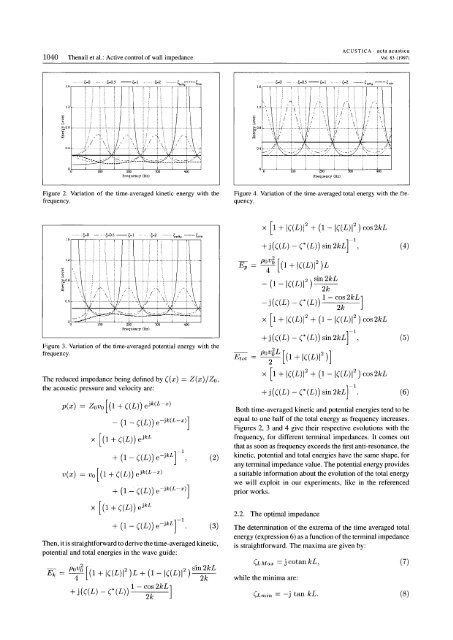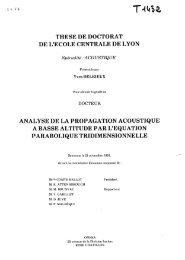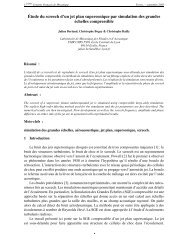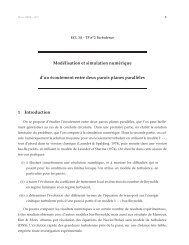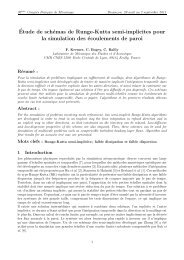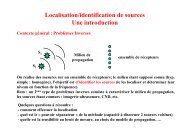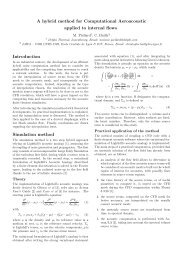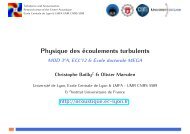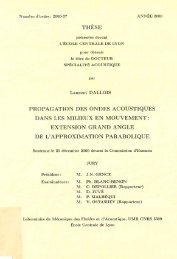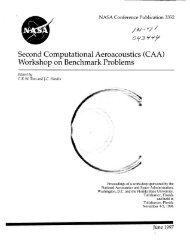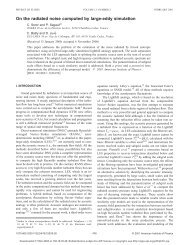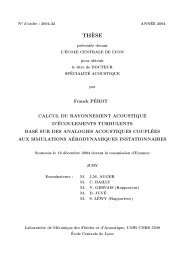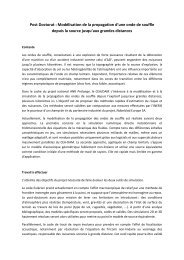The Active Control of Wall Impedance - Centre Acoustique
The Active Control of Wall Impedance - Centre Acoustique
The Active Control of Wall Impedance - Centre Acoustique
You also want an ePaper? Increase the reach of your titles
YUMPU automatically turns print PDFs into web optimized ePapers that Google loves.
1040 <strong>The</strong>nail et al.: <strong>Active</strong> control <strong>of</strong> wall impedance<br />
1.6<br />
1.2<br />
0.4<br />
a a 100 200 JOO<br />
Frequency (Hz)<br />
Figure 2. Variation <strong>of</strong> the time-averaged kinetic energy with the<br />
frequency.<br />
........,~O - - .'~O.S- ,~1 - - -,-2 - "Ofty ------- 'm'"<br />
16<br />
1.2<br />
0.4<br />
a - .:.::f.··--o<br />
100<br />
200 300<br />
Frequency (Hz)<br />
Figure 3. Variation <strong>of</strong> the time-averaged potential energy with the<br />
frequency.<br />
<strong>The</strong> reduced impedance being defined by ((X) = Z (x )/ Zo ,<br />
the acoustic pressure and velocity are:<br />
p(x) = ZOVO [(1 + ((L)) ejk(L-x)<br />
- (1- ((L)) e-jk(L-X)]<br />
x [(1 + ((L))e jkL<br />
v(x) = vo[(1 +((L)) ejk(L-x)<br />
+ (1-((L))e- jkLr1<br />
, (2)<br />
+ (1 - ((L)) e-jk(L-X)]<br />
x [(1+ ((L)) e jkL<br />
+ (1-((L))e- jkLr1<br />
. (3)<br />
<strong>The</strong>n, it is straightforward to derive the time-averaged kinetic,<br />
potential and total energies in the wave guide:<br />
poV6 [(1 + 1((L)1 2 )L + (1-1((L)12) sin2kL<br />
4 2k<br />
+ j(((L) _ (*(L)) 1- C;;2kL]<br />
400<br />
400<br />
ACUSTICA . acta acustica<br />
Vol. 83 (1997)<br />
Figure 4. Variation <strong>of</strong> the time-averaged total energy with the frequency.<br />
x [1 + 1((L)1 2 + (1-1((L)1 2 ) cos2kL<br />
+ j (((L) - (*(L)) sin2kLr1,<br />
2<br />
Ep = po;o [(1 + 1((L)1 2 )L<br />
_ (1-1((L)12) sin2kL<br />
2k<br />
_ j(((L) _ (*(L)) 1- COS2kL]<br />
2k<br />
x [1 + 1((L)1 2 + (1-1((L)12) cos2kL<br />
+ j(((L) - (*(L)) sin2kLrl,<br />
Etot = pO~6L [(1 + 1((L)1 2 )]<br />
X [1 + 1((L)1 2 + (1 - 1((L)1 2 ) cos 2kL<br />
+ j(((L) - (*(L)) sin2kLrl.<br />
Both time-averaged kinetic and potential energies tend to be<br />
equal to one half <strong>of</strong> the total energy as frequency increases.<br />
Figures 2, 3 and 4 give their respective evolutions with the<br />
frequency, for different terminal impedances. It comes out<br />
that as soon as frequency exceeds the first anti-resonance, the<br />
kinetic, potential and total energies have the same shape, for<br />
any terminal impedance value. <strong>The</strong> potential energy provides<br />
a suitable information about the evolution <strong>of</strong> the total energy<br />
we will exploit in {lur experiments, like in the referenced<br />
prior works.<br />
2.2. <strong>The</strong> optimal impedance<br />
<strong>The</strong> determination <strong>of</strong> the extrema <strong>of</strong> the time averaged total<br />
energy (expression 6) as a function <strong>of</strong> the terminal impedance<br />
is straightforward. <strong>The</strong> maxima are given by:<br />
(LMax = j cotan kL,<br />
while the minima are:<br />
(Lmin = -j tan kL.<br />
(4)<br />
(5)<br />
(6)<br />
(7)<br />
(8)


